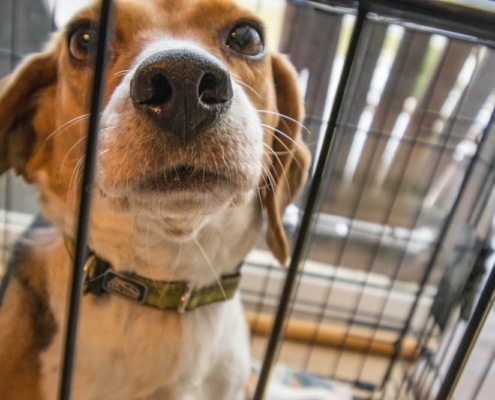Travelling With Your Cat and Dog
A good “pet traveller” has mastered certain skills, very similar to those used by humans for dealing with new and potentially stressful situations. The best advice for how to help cats and dogs become confident travellers is: start early and practice, practice, practice!
Get your dog and cat used to their carriers
Your pet will be the safest in his carrier, no matter what mode of travel you select. Travelling can be a lot of fun or a lot of hassle—we just never know in advance what can happen. Unexpected weather problems, flight delays, or road hazards can cause even a seasoned pet traveller to become anxious and stressed. Your pet’s personal crate offers secure containment and physical protection (against injury during loading, unloading, turbulence, or sudden maneuvers); as well as psychological comfort (a familiar scent, toys, and bedding can be very reassuring to your pet, especially if he is frightened).
Your pets’ carriers should help them feel comfortable and cozy, and be large enough so that they can stand up, turn around, and stretch a little.
Never, ever punish your pet by putting him into his carrier! You are trying to teach him to consider his crate as his personal and secure space. Lots of praise, some treats, and extra playtime are always much better teachers than scolding and banishment!
Place the carrier in your home, in a room where you and your family relax. Put a blanket, a toy, and an old piece of your clothing (for scent) into the carrier, and open the door. Leave the door open, and allow your pet to freely enter and exit. When you feel that the animal is comfortable in his space, close the door for a few minutes. If your pet doesn’t become agitated, begin to increase his time inside with the door closed. Your goal is to have your pet conditioned to be at ease in his carrier, with no whining, barking, meowing, or attempts at escape.
At this stage, you can try lifting and moving the cage with your pet inside. If you intend to travel by car, and your pet will stay in this carrier during the road trip, put the carrier into the car, so that he gets comfortable with the experience. If your pet will be flying, close the door to his cage and leave him alone for a while.
Never allow your pet to become too agitated during this stage of training. If he starts to panic, leave the door open again, and continue when he feels more comfortable. Some animals may just never become good travellers.
For an in depth discussion on crate training, see our article at https://apetslife.ca/crate-training/.
Motoring with Fido – make it fun!
So often the only car trips your dog goes on are to the vet, (ouch!) boarding kennel, (don’t leave me!) or groomer (the water’s freezing!). These trips may inadvertently be teaching your dog that the car is associated only with unpleasant experiences.
Take your dog on practice runs to get him used to travelling in the car for a fun time—try a new dog park, or take him for a walk on leash in a new location. He will get used to using his nose to explore, and will also become socialized to new places, people, sounds, and smells. The more you practice these “mini vacations” the more relaxed and confident he will be when you finally head out for parts unknown, and will help both of you get into a groove of dealing with strange places and people together.
Your dog should travel in either his carrier or a travel harness, also known as a seatbelt harness. All carriers and harnesses should be threaded through and secured to the car’s seatbelt, to avoid a disaster should you make a sudden stop.
- Animals allowed to “roam free” in the car can become dangerous projectiles in an accident, harming other passengers and/or themselves.
- Dogs should not be free to stick their heads out of a completely rolled down window, as they can lose their balance and fall out of the car. Dirt, dust, and debris can blow directly into your pet’s eyes and ears as well, causing infections to develop.
- Even if you have a tiny dog or cat, never let him sit on your lap, jump around the car or “co-pilot”—this is not cute, and is extremely dangerous for you, your pet, and all other drivers on the road. Cats and small dogs can jump easily, dig their claws into you, or become lodged under the brake or gas pedal!
Your dog cannot travel in the bed of a pickup truck unprotected. Horrible accidents can occur during a sudden stop or turn, causing your pet to be thrown off his feet or even thrown off the truck and into the road. Attaching your pet with a leash can prove deadly, too, if the leash is long enough to strangle the animal, or drag him on the ground should he fall off the truck. Again, a secured crate is always your safest option.
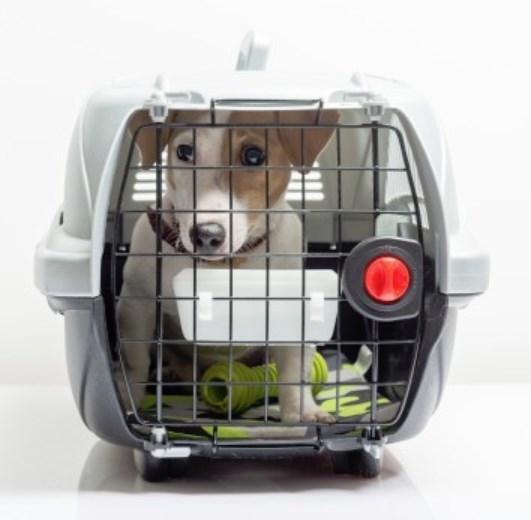 Plan Ahead
Plan Ahead
Have your pet checked out by your veterinarian prior to vacationing to ensure a clean bill of health, and make sure to give him all the required vaccinations in the time frame specified by the policies of your country of destination.
If your animal has a microchip, update your emergency phone numbers to include a cell phone and a destination number (call your service provider for info on how to update or change your information).
Don’t count on every hotel or motel to allow pets. Even if they do, there might be additional fees, deposits, or non-refundable cleaning charges. Not all camping grounds allow pets, and some places may ban specific breeds of dogs, or even dogs that resemble specific breeds. If you have an animal that could be mistaken for a prohibited breed, DNA proof might be your only solution.
If you intend to travel by bus with your pet, call the company and ask about their policies—most bus companies do not transport any pets other than service dogs.
Pack a “pet bag” and keep it easily accessible in the car
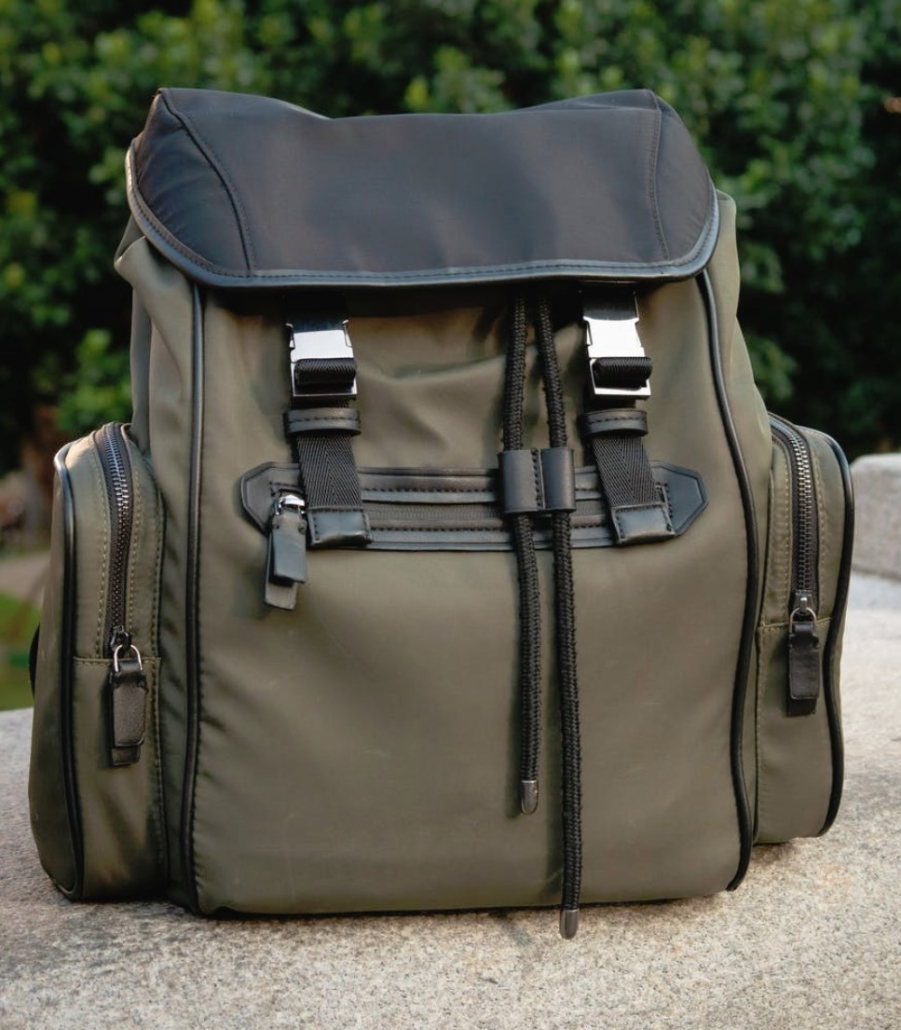 It’s no use taking along your pet’s medications, toys, or water if you have to unpack the whole car to find something! Make sure your pet bag is easy to reach and well stocked.
It’s no use taking along your pet’s medications, toys, or water if you have to unpack the whole car to find something! Make sure your pet bag is easy to reach and well stocked.
Your pet bag should include the following:
- A first aid kit, including tweezers, any meds your pet takes, eye drops, and ear powder. (In the months prior to your trip, consider enrolling in a pet first aid course. If you find yourself stuck on the highway in traffic, or in a strange city, miles from a veterinary clinic, the skills you learn may help you save your pet’s life. For information on where to find a first aid course in Victoria, see https://apetslife.ca/pet-first-aid/.)
- A comfort kit (your pet’s food, water, bowls, treats, favourite toy, kitty litter, extra bedding and/or blankets)
- Proof of vaccinations as required by any province, state, or country you plan to visit
- Information about vets and emergency care en route and at your final destination (check to see if they are still in business!)
- Dog collar, leash, and muzzle (in case your pet has to be treated by an unfamiliar vet and becomes agitated)
- Animal sunscreen (ears, noses, and paws are very susceptible to sunburns, as are all small animals, albinos, short-haired, and hairless breeds!)
You may get stuck in bad weather or traffic, or take longer to “smell the roses” than you initially scheduled. Bring along extra food and water—you never want to have your pet try a new food on a car trip—this can be a disaster for his digestion, and a mess for you to clean up!
Motion Sickness
Chances are what we attribute as motion sickness in a dog or cat is not related to the actual movement of the vehicle, but rather to the animal’s fear and anxiety.

There are, of course, some pets who do not travel well at all, and do suffer from actual motion sickness. While herbal remedies (available over-the-counter) containing ginger, valerian root, and/or peppermint may help, your vet might feel a prescription drug is required.
Be sure to speak to your veterinarian before administering any over-the-counter remedy.
Signs of motion sickness are:
- Yawning
- Drooling
- Diarrhea, urination
- Crying, meowing, barking, whining
This can certainly make any road trip loud, messy, and terrifying for the animal suffering, and unbearable for drivers and passengers.
If you have trained your pet to become used to travelling by car and he is looking forward to his outings, chances are he will not have an upset tummy
Try to exercise your dog prior to getting into the car by taking him for a long walk, so that he can use his pent up energy, (whether it be excitement or nerves), and relieve himself.
Don’t feed your pet a big meal right before he gets into the car (and never in the car). Some animals like to travel on empty tummies, while others prefer a little food—get to know your pet during your practice runs.
Keep a supply of fresh water in the car (you can freeze a bottle of water prior to leaving, and allow it to defrost en route). Stop every few hours to let your pet stretch, have a drink, relieve himself, and play a little if possible.
Some easy-to-clean (or disposable) car seat protectors might be a very good investment!
Finally, a car heats up and cools down rapidly when parked. Never leave your pet alone, locked in the car—he may freeze to death or succumb to heat stroke very quickly.
Air travel can be extremely stressful for a cat or dog
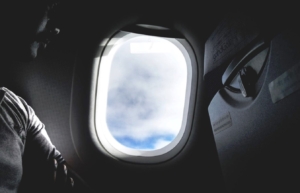 It is absolutely essential to plan ahead! While there are federal laws regarding transportation of live animals, each individual airline has its own policies, guidelines, and requirements, covering everything from type of carrier to whether or not your pet can be medicated. Research can begin online, but before you purchase a ticket for yourself and your pet, call the selected airline to make sure that your information is up-to-date.
It is absolutely essential to plan ahead! While there are federal laws regarding transportation of live animals, each individual airline has its own policies, guidelines, and requirements, covering everything from type of carrier to whether or not your pet can be medicated. Research can begin online, but before you purchase a ticket for yourself and your pet, call the selected airline to make sure that your information is up-to-date.
Before you and your pet fly, think about what can happen during an airplane trip:
- Pets separated from their owners
- Dogs travelling in the cargo section of a plane
- Animals alone in their cages for hours, perhaps being not-so-gently tossed about by baggage handlers…I think you get the idea
Consider the following:
- Make sure your selected airline has a climate controlled, pressurized cargo section
- Invest in the best quality and most comfortable airline-approved carrier you can afford (it must have a leak-proof bottom and good ventilation)
- Remember that if the temperature at take-off is too extreme (hot or cold) your pet will not be allowed to travel (have Plan B set up in the event you can fly but your pet cannot, or some version of this problem!)
- Try to book early morning or late evening flights with your pet (the weather will be milder)
- Try to book non-stop, direct flights, to avoid the stress of loading and reloading on your pet; or the risk of losing or getting separated from him
Safety precautions during the flight:
- Do not place any collar or leash around your pet’s neck while they are inside their cage—an animal dealing with anxiety may accidently strangle himself
- Attach a ticket with your name, the dog’s name, your phone number, the dog’s destination, and who will pick him up to the top of his carrier. Include a recent picture of your pet, in case his cage opens and he escapes, or winds up on the wrong flight.
- Keep a copy of the picture with you on the plane, in case you have to show it to airline staff in an emergency
- Mark directional arrows on the carrier to show which direction is “up”
- Write “live animal” on the carrier so a handler clearly recognizes the precious cargo inside
Following are some general “travel-by-air” guidelines to consider—but remember that each airline and country have their own rules regarding pet travel. You can do your initial research online, but always call prior to booking to make sure that the information you have is up-to-date.
You may require an acclimation certificate, a bill of good health and/or proof of vaccinations (and proof, i.e., a serology report, that the vaccines have “taken” in the animal) from a licensed veterinarian.
Depending on the specific regulations of the destination country, your pet may be placed in quarantine for a period of a few weeks to many months.
If you are travelling out of the country, you and your pet must clear customs. At this point you may be required to remove your pet from his carrier in order to have it X-rayed empty. Have a leash and muzzle on hand.
Generally, puppies must be at least 8 weeks old and fully weaned to fly; kittens 10 weeks old. Pregnant and/or elderly pets should not fly.
Tranquilizing and Sedation
Most airlines do not permit animals to fly under sedation.
This is done to ensure your pet’s safety, as the animal’s natural ability to balance, regain balance, or brace himself can become compromised under sedation. Animals, especially anxious ones, can respond very differently than intended to tranquilizers and/or sedatives, some becoming highly agitated, others seeing heart rates slow to such an extreme that they cannot be revived upon landing.
Brachycephalic (meaning short-headed) cats and dogs, such as English and French Bulldogs, Pekingese, Himalayans, Pugs, and Boxers, have been bred to display normal-sized lower jaws (in relation to their body mass), and compressed upper jaws. These traits make the animals particularly prone to respiratory and cardio-vascular problems, which can be exacerbated by exposure to increased-altitude pressure, and can prove fatal if the animal is sedated or tranquilized.
 By Sea
By Sea
It is best to make sure that your pet has his sea legs before your trip—if you can, bring him to the marina and have him practice getting on and off the boat.
Do not allow your pet to roam free on a boat. Dogs should be on leash.
Boat surfaces can become very hot and/or very slippery. Non-skid mats will help.
It is extremely difficult to put on a flotation device during an emergency. Having life preservers on board may be useless if you and your pet aren’t wearing them! Even if your dog is an experienced and happy swimmer, a state of panic can induce unpredictable actions.
Purchase an approved flotation device, get your dog used to wearing it, and put it on him for the duration of the trip!
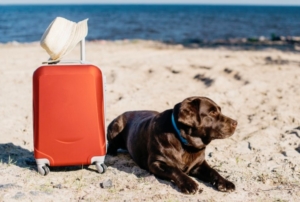 Bon Voyage!
Bon Voyage!
A few words of encouragement:
Cats are not known for their fondness of travel, and your pet might meow like crazy during your trip. Talk quietly and reassuringly to your pet; let her see you if possible. Remember, your cat is not demonstrating her diva behaviour—she is acting out her fear!
In order to be a good traveller, your dog should have basic obedience training (sit, stay, quiet, come) and be socialized with other pets and humans.
The more relaxed and confident your pet is in new situations, the fewer problems you will have on your journeys.
Have a wonderful and safe vacation, and “may the road rise to meet you” and your pet!

